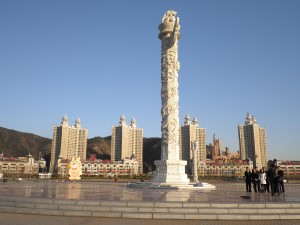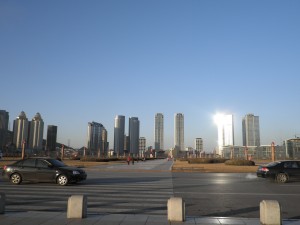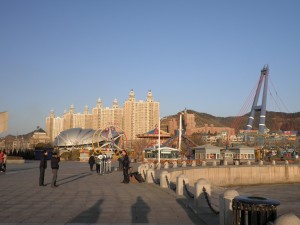Xian, China
Train ticket (around 55 Yuan) is much cheaper than the bus ticket (90 Yuan) to Xian. Was trying to take the 7.12am train to Xian but got an 8am train (K59 from XuZhou) instead and the train was delayed for another 1.30 hours.
Arrived at Xian train station at almost 3pm.
![P1313467 [640x480]](http://journey26.com/blog/wp-content/uploads/2010/02/P1313467-640x480-300x225.jpg)
Xian train station was pretty crowded. Met a young man, Du on the train and dragged him along to the hostel since he has never heard about youth hostel. Took bus 603 to NanMen and found a youth hostel called XiangZiMen. Originally I was planning to stay at ShuYuan hostel but I lost the address and found XiangZiMen hostel instead.
![P1313469 [640x480]](http://journey26.com/blog/wp-content/uploads/2010/02/P1313469-640x480-225x300.jpg)
XiangZiMen hostel (30 Yuan~USD$4.5 for a 6 beds dorm room)
![P2023550 [640x480]](http://journey26.com/blog/wp-content/uploads/2010/02/P2023550-640x480-300x225.jpg)
Shaanxi has a very long and interesting history. It’s considered the heart of Chinese civilization, Xian is the capital for Shaanxi province and is one of the oldest Chinese city, more than 3000 years old. The city has been the capital of some of the very old dynasties. Xi’an became a cultural and political center of China in 1100 BC with the founding of the Zhou Dynasty. During the Sui dynasty, Xian was the largest city in the world with a wall enclosing the city of 84 km^2. But during the end of Tang dynasty, Xian was destroyed.
A wall around the city was constructed during the Ming dynasty in 1370 with 12km long, 12meters high and 15-18 meters thick, the wall still remain intact today.
![P1313471 [640x480]](http://journey26.com/blog/wp-content/uploads/2010/02/P1313471-640x480-300x225.jpg)
Today, Xian has a population of around 8 millions.
Walked back to the train station. Passed by GeMinGongYuan.
![P1313486 [640x480]](http://journey26.com/blog/wp-content/uploads/2010/02/P1313486-640x480-300x225.jpg)
Older generation dancing hip hop
![P1313485 [640x480]](http://journey26.com/blog/wp-content/uploads/2010/02/P1313485-640x480-300x225.jpg)
Arranged marriages are still popular in China and many old people gather here to exchange information about the availability of their sons and daughters.
![P1313487 [640x480]](http://journey26.com/blog/wp-content/uploads/2010/02/P1313487-640x480-300x225.jpg)
Advertisement about looking for a partner
![P1313488 [640x480]](http://journey26.com/blog/wp-content/uploads/2010/02/P1313488-640x480-300x225.jpg)
Took bus 5 to DaYanTa. The pagoda was constructed in 652 AD to store the Buddhist sutras obtained by Xuan Zang from India. The pagoda has a height of 64 meters.
![P1313492 [640x480]](http://journey26.com/blog/wp-content/uploads/2010/01/P1313492-640x480-300x225.jpg)
South of DaYanTa is BuYeCheng.
Mr. Du was pretty photogenic and loved posing for photos.
![P1313502 [640x480]](http://journey26.com/blog/wp-content/uploads/2010/01/P1313502-640x480-300x225.jpg)
Walked to TangFuRongYuan, a recent built park with buildings similar to Tang structures in ancient times.
![P1313512 [640x480]](http://journey26.com/blog/wp-content/uploads/2010/01/P1313512-640x480-300x225.jpg)
Took bus 26 to GuLou and went to HuiMinJie for food.
![CIMG7084 [640x480]](http://journey26.com/blog/wp-content/uploads/2010/01/CIMG7084-640x480-300x225.jpg)
Dinner, fried rice with meat on sticks and a drink. (10 Yuan~USD$1.4)
![CIMG7087 [640x480]](http://journey26.com/blog/wp-content/uploads/2010/01/CIMG7087-640x480-300x225.jpg)
Finally got back to the hostel around 11pm after walking around for 8 hours today.
![P1313474 [640x480]](http://journey26.com/blog/wp-content/uploads/2010/02/P1313474-640x480-300x225.jpg)
![P1313481 [640x480]](http://journey26.com/blog/wp-content/uploads/2010/02/P1313481-640x480-300x225.jpg)
![P1313482 [640x480]](http://journey26.com/blog/wp-content/uploads/2010/02/P1313482-640x480-300x225.jpg)
![P1313505 [640x480]](http://journey26.com/blog/wp-content/uploads/2010/01/P1313505-640x480-300x225.jpg)
![P1313506 [640x480]](http://journey26.com/blog/wp-content/uploads/2010/01/P1313506-640x480-300x225.jpg)
![P1313507 [640x480]](http://journey26.com/blog/wp-content/uploads/2010/01/P1313507-640x480-300x225.jpg)
![P1313510 [640x480]](http://journey26.com/blog/wp-content/uploads/2010/01/P1313510-640x480-300x225.jpg)
![CIMG7078 [640x480]](http://journey26.com/blog/wp-content/uploads/2010/01/CIMG7078-640x480-300x225.jpg)
![CIMG7082 [640x480]](http://journey26.com/blog/wp-content/uploads/2010/01/CIMG7082-640x480-225x300.jpg)
![P1303411 [640x480]](http://journey26.com/blog/wp-content/uploads/2010/02/P1303411-640x480-300x225.jpg)
![P1303413 [640x480]](http://journey26.com/blog/wp-content/uploads/2010/02/P1303413-640x480-300x225.jpg)
![P1303416 [640x480]](http://journey26.com/blog/wp-content/uploads/2010/02/P1303416-640x480-225x300.jpg)
![P1303420 [640x480]](http://journey26.com/blog/wp-content/uploads/2010/02/P1303420-640x480-225x300.jpg)
![P1303423 [640x480]](http://journey26.com/blog/wp-content/uploads/2010/02/P1303423-640x480-300x225.jpg)
![P1303429 [640x480]](http://journey26.com/blog/wp-content/uploads/2010/02/P1303429-640x480-300x225.jpg)
![P1303434 [640x480]](http://journey26.com/blog/wp-content/uploads/2010/02/P1303434-640x480-300x225.jpg)
![P1303442 [640x480]](http://journey26.com/blog/wp-content/uploads/2010/02/P1303442-640x480-300x225.jpg)
![P1303440 [640x480]](http://journey26.com/blog/wp-content/uploads/2010/02/P1303440-640x480-300x225.jpg)
![P1303445 [640x480]](http://journey26.com/blog/wp-content/uploads/2010/02/P1303445-640x480-300x225.jpg)
![P1303448 [640x480]](http://journey26.com/blog/wp-content/uploads/2010/02/P1303448-640x480-300x225.jpg)
![P1303450 [640x480]](http://journey26.com/blog/wp-content/uploads/2010/02/P1303450-640x480-300x225.jpg)
![P1303453 [640x480]](http://journey26.com/blog/wp-content/uploads/2010/02/P1303453-640x480-300x225.jpg)
![P1303457 [640x480]](http://journey26.com/blog/wp-content/uploads/2010/02/P1303457-640x480-300x225.jpg)
![P1293351 [640x480]](http://journey26.com/blog/wp-content/uploads/2010/01/P1293351-640x480-225x300.jpg)
![P1293353 [640x480]](http://journey26.com/blog/wp-content/uploads/2010/01/P1293353-640x480-300x225.jpg)
![P1293354 [640x480]](http://journey26.com/blog/wp-content/uploads/2010/01/P1293354-640x480-300x225.jpg)
![CIMG7072 [640x480]](http://journey26.com/blog/wp-content/uploads/2010/01/CIMG7072-640x480-300x225.jpg)
![P1293356 [640x480]](http://journey26.com/blog/wp-content/uploads/2010/01/P1293356-640x480-300x225.jpg)
![P1293359 [640x480]](http://journey26.com/blog/wp-content/uploads/2010/01/P1293359-640x480-300x225.jpg)
![P1293367 [640x480]](http://journey26.com/blog/wp-content/uploads/2010/01/P1293367-640x480-300x225.jpg)
![P1293366 [640x480]](http://journey26.com/blog/wp-content/uploads/2010/01/P1293366-640x480-225x300.jpg)
![P1293378 [640x480]](http://journey26.com/blog/wp-content/uploads/2010/01/P1293378-640x480-300x225.jpg)
![P1293381 [640x480]](http://journey26.com/blog/wp-content/uploads/2010/01/P1293381-640x480-300x225.jpg)
![P1293382 [640x480]](http://journey26.com/blog/wp-content/uploads/2010/01/P1293382-640x480-300x225.jpg)
![P1293385 [640x480]](http://journey26.com/blog/wp-content/uploads/2010/01/P1293385-640x480-225x300.jpg)
![P1293387 [640x480]](http://journey26.com/blog/wp-content/uploads/2010/01/P1293387-640x480-300x225.jpg)
![P1293388 [640x480]](http://journey26.com/blog/wp-content/uploads/2010/01/P1293388-640x480-300x225.jpg)
![CIMG7055 [640x480]](http://journey26.com/blog/wp-content/uploads/2010/01/CIMG7055-640x480-300x225.jpg)
![P1293405 [640x480]](http://journey26.com/blog/wp-content/uploads/2010/01/P1293405-640x480-300x225.jpg)
![CIMG7061 [640x480]](http://journey26.com/blog/wp-content/uploads/2010/01/CIMG7061-640x480-300x225.jpg)
![CIMG7069 [640x480]](http://journey26.com/blog/wp-content/uploads/2010/01/CIMG7069-640x480-300x225.jpg)
![CIMG7070 [640x480]](http://journey26.com/blog/wp-content/uploads/2010/01/CIMG7070-640x480-300x225.jpg)
![CIMG7076 [640x480]](http://journey26.com/blog/wp-content/uploads/2010/01/CIMG7076-640x480-300x225.jpg)
![P1283304 [640x480]](http://journey26.com/blog/wp-content/uploads/2010/02/P1283304-640x480-300x225.jpg)
![P1283311 [640x480]](http://journey26.com/blog/wp-content/uploads/2010/02/P1283311-640x480-225x300.jpg)
![P1283310 [640x480]](http://journey26.com/blog/wp-content/uploads/2010/02/P1283310-640x480-225x300.jpg)
![P1283307 [640x480]](http://journey26.com/blog/wp-content/uploads/2010/01/P1283307-640x480-300x225.jpg)
![P1283323 [640x480]](http://journey26.com/blog/wp-content/uploads/2010/01/P1283323-640x480-300x225.jpg)
![P1283325 [640x480]](http://journey26.com/blog/wp-content/uploads/2010/01/P1283325-640x480-300x225.jpg)
![P1283336 [640x480]](http://journey26.com/blog/wp-content/uploads/2010/01/P1283336-640x480-300x225.jpg)
![P1283338 [640x480]](http://journey26.com/blog/wp-content/uploads/2010/01/P1283338-640x480-300x225.jpg)
![P1283346 [640x480]](http://journey26.com/blog/wp-content/uploads/2010/01/P1283346-640x480-300x225.jpg)
![P1283350 [640x480]](http://journey26.com/blog/wp-content/uploads/2010/01/P1283350-640x480-300x225.jpg)
![P1273257 [640x480]](http://journey26.com/blog/wp-content/uploads/2010/01/P1273257-640x480-300x225.jpg)
![P1273260 [640x480]](http://journey26.com/blog/wp-content/uploads/2010/01/P1273260-640x480-300x225.jpg)
![P1273270 [640x480]](http://journey26.com/blog/wp-content/uploads/2010/01/P1273270-640x480-300x225.jpg)
![P1273271 [640x480]](http://journey26.com/blog/wp-content/uploads/2010/01/P1273271-640x480-300x225.jpg)
![P1273274 [640x480]](http://journey26.com/blog/wp-content/uploads/2010/01/P1273274-640x480-300x225.jpg)
![P1273277 [640x480]](http://journey26.com/blog/wp-content/uploads/2010/01/P1273277-640x480-300x225.jpg)
![CIMG7008 [640x480]](http://journey26.com/blog/wp-content/uploads/2010/01/CIMG7008-640x480-300x225.jpg)
![CIMG7012 [640x480]](http://journey26.com/blog/wp-content/uploads/2010/01/CIMG7012-640x480-300x225.jpg)
![CIMG7015 [640x480]](http://journey26.com/blog/wp-content/uploads/2010/01/CIMG7015-640x480-300x225.jpg)
![CIMG7020 [640x480]](http://journey26.com/blog/wp-content/uploads/2010/01/CIMG7020-640x480-300x225.jpg)
![CIMG7021 [640x480]](http://journey26.com/blog/wp-content/uploads/2010/01/CIMG7021-640x480-300x225.jpg)
![CIMG7031 [640x480]](http://journey26.com/blog/wp-content/uploads/2010/01/CIMG7031-640x480-225x300.jpg)
![CIMG7044 [640x480]](http://journey26.com/blog/wp-content/uploads/2010/01/CIMG7044-640x480-300x225.jpg)
![CIMG7047 [640x480]](http://journey26.com/blog/wp-content/uploads/2010/01/CIMG7047-640x480-300x225.jpg)
![CIMG7050 [640x480]](http://journey26.com/blog/wp-content/uploads/2010/01/CIMG7050-640x480-300x225.jpg)
![CIMG7051 [640x480]](http://journey26.com/blog/wp-content/uploads/2010/01/CIMG7051-640x480-300x225.jpg)
![P1273279 [640x480]](http://journey26.com/blog/wp-content/uploads/2010/01/P1273279-640x480-300x225.jpg)
![P1273280 [640x480]](http://journey26.com/blog/wp-content/uploads/2010/01/P1273280-640x480-300x225.jpg)
![P1273283 [640x480]](http://journey26.com/blog/wp-content/uploads/2010/01/P1273283-640x480-300x225.jpg)
![P1273285 [640x480]](http://journey26.com/blog/wp-content/uploads/2010/01/P1273285-640x480-300x225.jpg)
![P1273286 [640x480]](http://journey26.com/blog/wp-content/uploads/2010/01/P1273286-640x480-300x225.jpg)
![P1273291 [640x480]](http://journey26.com/blog/wp-content/uploads/2010/01/P1273291-640x480-300x225.jpg)
![P1273297 [640x480]](http://journey26.com/blog/wp-content/uploads/2010/01/P1273297-640x480-300x225.jpg)
![P1263183 [640x480]](http://journey26.com/blog/wp-content/uploads/2010/01/P1263183-640x480-300x225.jpg)
![P1263191 [640x480]](http://journey26.com/blog/wp-content/uploads/2010/01/P1263191-640x480-300x225.jpg)
![P1263192 [640x480]](http://journey26.com/blog/wp-content/uploads/2010/01/P1263192-640x480-300x225.jpg)
![P1263206 [640x480]](http://journey26.com/blog/wp-content/uploads/2010/01/P1263206-640x480-300x225.jpg)
![P1263207 [640x480]](http://journey26.com/blog/wp-content/uploads/2010/01/P1263207-640x480-300x225.jpg)
![P1263208 [640x480]](http://journey26.com/blog/wp-content/uploads/2010/01/P1263208-640x480-300x225.jpg)
![P1263215 [640x480]](http://journey26.com/blog/wp-content/uploads/2010/01/P1263215-640x480-300x225.jpg)
![P1263217 [640x480]](http://journey26.com/blog/wp-content/uploads/2010/01/P1263217-640x480-300x225.jpg)
![P1263225 [640x480]](http://journey26.com/blog/wp-content/uploads/2010/01/P1263225-640x480-300x225.jpg)
![P1263228 [640x480]](http://journey26.com/blog/wp-content/uploads/2010/01/P1263228-640x480-300x225.jpg)
![P1263227 [640x480]](http://journey26.com/blog/wp-content/uploads/2010/01/P1263227-640x480-300x225.jpg)
![P1263231 [640x480]](http://journey26.com/blog/wp-content/uploads/2010/01/P1263231-640x480-300x225.jpg)
![P1263239 [640x480]](http://journey26.com/blog/wp-content/uploads/2010/01/P1263239-640x480-300x225.jpg)
![P1263241 [640x480]](http://journey26.com/blog/wp-content/uploads/2010/01/P1263241-640x480-300x225.jpg)
![P1263242 [640x480]](http://journey26.com/blog/wp-content/uploads/2010/01/P1263242-640x480-225x300.jpg)
![P1263240 [640x480]](http://journey26.com/blog/wp-content/uploads/2010/01/P1263240-640x480-300x225.jpg)
![P1263251 [640x480]](http://journey26.com/blog/wp-content/uploads/2010/01/P1263251-640x480-300x225.jpg)
![P1263253 [640x480]](http://journey26.com/blog/wp-content/uploads/2010/01/P1263253-640x480-300x225.jpg)
![P1263256 [640x480]](http://journey26.com/blog/wp-content/uploads/2010/01/P1263256-640x480-300x225.jpg)
![P1253093 [640x480]](http://journey26.com/blog/wp-content/uploads/2010/01/P1253093-640x480-300x225.jpg)
![P1253091 [640x480]](http://journey26.com/blog/wp-content/uploads/2010/01/P1253091-640x480-300x225.jpg)
![P1253102 [640x480]](http://journey26.com/blog/wp-content/uploads/2010/01/P1253102-640x480-300x225.jpg)
![P1253106 [640x480]](http://journey26.com/blog/wp-content/uploads/2010/01/P1253106-640x480-300x225.jpg)
![P1253107 [640x480]](http://journey26.com/blog/wp-content/uploads/2010/01/P1253107-640x480-300x225.jpg)
![P1253118 [640x480]](http://journey26.com/blog/wp-content/uploads/2010/01/P1253118-640x480-300x225.jpg)
![P1253124 [640x480]](http://journey26.com/blog/wp-content/uploads/2010/01/P1253124-640x480-300x225.jpg)
![P1253131 [640x480]](http://journey26.com/blog/wp-content/uploads/2010/01/P1253131-640x480-300x225.jpg)
![P1253150 [640x480]](http://journey26.com/blog/wp-content/uploads/2010/01/P1253150-640x480-300x225.jpg)
![P1253165 [640x480]](http://journey26.com/blog/wp-content/uploads/2010/01/P1253165-640x480-300x225.jpg)
![P1253136 [640x480]](http://journey26.com/blog/wp-content/uploads/2010/01/P1253136-640x480-225x300.jpg)
![P1253142 [640x480]](http://journey26.com/blog/wp-content/uploads/2010/01/P1253142-640x480-300x225.jpg)
![P1253166 [640x480]](http://journey26.com/blog/wp-content/uploads/2010/01/P1253166-640x480-300x225.jpg)
![P1253167 [640x480]](http://journey26.com/blog/wp-content/uploads/2010/01/P1253167-640x480-300x225.jpg)
![P1253168 [640x480]](http://journey26.com/blog/wp-content/uploads/2010/01/P1253168-640x480-300x225.jpg)
![P1253175 [640x480]](http://journey26.com/blog/wp-content/uploads/2010/01/P1253175-640x480-300x225.jpg)
![P1253177 [640x480]](http://journey26.com/blog/wp-content/uploads/2010/01/P1253177-640x480-300x225.jpg)
![P1253179 [640x480]](http://journey26.com/blog/wp-content/uploads/2010/01/P1253179-640x480-300x225.jpg)
![P1243039 [640x480]](http://journey26.com/blog/wp-content/uploads/2010/01/P1243039-640x480-300x225.jpg)
![P1243041 [640x480]](http://journey26.com/blog/wp-content/uploads/2010/01/P1243041-640x480-300x225.jpg)
![P1243043 [640x480]](http://journey26.com/blog/wp-content/uploads/2010/01/P1243043-640x480-300x225.jpg)
![P1243045 [640x480]](http://journey26.com/blog/wp-content/uploads/2010/01/P1243045-640x480-300x225.jpg)
![P1243046 [640x480]](http://journey26.com/blog/wp-content/uploads/2010/01/P1243046-640x480-300x225.jpg)
![P1253180 [640x480]](http://journey26.com/blog/wp-content/uploads/2010/01/P1253180-640x480-300x225.jpg)
![P1243048 [640x480]](http://journey26.com/blog/wp-content/uploads/2010/01/P1243048-640x480-300x225.jpg)
![P1243054 [640x480]](http://journey26.com/blog/wp-content/uploads/2010/01/P1243054-640x480-300x225.jpg)
![P1243055 [640x480]](http://journey26.com/blog/wp-content/uploads/2010/01/P1243055-640x480-300x225.jpg)
![P1243056 [640x480]](http://journey26.com/blog/wp-content/uploads/2010/01/P1243056-640x480-300x225.jpg)
![P1243057 [640x480]](http://journey26.com/blog/wp-content/uploads/2010/01/P1243057-640x480-300x225.jpg)
![P1243062 [640x480]](http://journey26.com/blog/wp-content/uploads/2010/01/P1243062-640x480-300x225.jpg)
![P1243064 [640x480]](http://journey26.com/blog/wp-content/uploads/2010/01/P1243064-640x480-300x225.jpg)
![P1243071 [640x480]](http://journey26.com/blog/wp-content/uploads/2010/01/P1243071-640x480-300x225.jpg)
![P1243074 [640x480]](http://journey26.com/blog/wp-content/uploads/2010/01/P1243074-640x480-300x225.jpg)
![P1243079 [640x480]](http://journey26.com/blog/wp-content/uploads/2010/01/P1243079-640x480-300x225.jpg)
![P1243082 [640x480]](http://journey26.com/blog/wp-content/uploads/2010/01/P1243082-640x480-300x225.jpg)
![P1243083 [640x480]](http://journey26.com/blog/wp-content/uploads/2010/01/P1243083-640x480-300x225.jpg)
![P1243086 [640x480]](http://journey26.com/blog/wp-content/uploads/2010/01/P1243086-640x480-300x225.jpg)
![P1232975 [640x480]](http://journey26.com/blog/wp-content/uploads/2010/01/P1232975-640x480-300x225.jpg)
![P1232976 [640x480]](http://journey26.com/blog/wp-content/uploads/2010/01/P1232976-640x480-300x225.jpg)
![P1232978 [640x480]](http://journey26.com/blog/wp-content/uploads/2010/01/P1232978-640x480-300x225.jpg)
![P1232981 [640x480]](http://journey26.com/blog/wp-content/uploads/2010/01/P1232981-640x480-300x225.jpg)
![P1232988 [640x480]](http://journey26.com/blog/wp-content/uploads/2010/01/P1232988-640x480-300x225.jpg)
![P1232989 [640x480]](http://journey26.com/blog/wp-content/uploads/2010/01/P1232989-640x480-300x225.jpg)
![P1232991 [640x480]](http://journey26.com/blog/wp-content/uploads/2010/01/P1232991-640x480-300x225.jpg)
![P1232995 [640x480]](http://journey26.com/blog/wp-content/uploads/2010/01/P1232995-640x480-300x225.jpg)
![P1232997 [640x480]](http://journey26.com/blog/wp-content/uploads/2010/01/P1232997-640x480-300x225.jpg)
![P1232998 [640x480]](http://journey26.com/blog/wp-content/uploads/2010/01/P1232998-640x480-300x225.jpg)
![P1222944 [640x480]](http://journey26.com/blog/wp-content/uploads/2010/01/P1222944-640x480-300x225.jpg)
![P1233004 [640x480]](http://journey26.com/blog/wp-content/uploads/2010/01/P1233004-640x480-300x225.jpg)
![P1233012 [640x480]](http://journey26.com/blog/wp-content/uploads/2010/01/P1233012-640x480-300x225.jpg)
![P1233018 [640x480]](http://journey26.com/blog/wp-content/uploads/2010/01/P1233018-640x480-300x225.jpg)
![P1233019 [640x480]](http://journey26.com/blog/wp-content/uploads/2010/01/P1233019-640x480-300x225.jpg)
![P1233023 [640x480]](http://journey26.com/blog/wp-content/uploads/2010/01/P1233023-640x480-300x225.jpg)
![P1233025 [640x480]](http://journey26.com/blog/wp-content/uploads/2010/01/P1233025-640x480-300x225.jpg)
![P1233028 [640x480]](http://journey26.com/blog/wp-content/uploads/2010/01/P1233028-640x480-300x225.jpg)
![P1233033 [640x480]](http://journey26.com/blog/wp-content/uploads/2010/01/P1233033-640x480-300x225.jpg)
![P1243037 [640x480]](http://journey26.com/blog/wp-content/uploads/2010/01/P1243037-640x480-300x225.jpg)
![P1243038 [640x480]](http://journey26.com/blog/wp-content/uploads/2010/01/P1243038-640x480-300x225.jpg)
![P1222928 [640x480]](http://journey26.com/blog/wp-content/uploads/2010/01/P1222928-640x480-300x225.jpg)
![P1222929 [640x480]](http://journey26.com/blog/wp-content/uploads/2010/01/P1222929-640x480-300x225.jpg)
![P1222931 [640x480]](http://journey26.com/blog/wp-content/uploads/2010/01/P1222931-640x480-300x225.jpg)
![P1222934 [640x480]](http://journey26.com/blog/wp-content/uploads/2010/01/P1222934-640x480-300x225.jpg)
![P1222936 [640x480]](http://journey26.com/blog/wp-content/uploads/2010/01/P1222936-640x480-300x225.jpg)
![P1222937 [640x480]](http://journey26.com/blog/wp-content/uploads/2010/01/P1222937-640x480-300x225.jpg)




![P1222955 [640x480]](http://journey26.com/blog/wp-content/uploads/2010/01/P1222955-640x480-300x225.jpg)
![P1222956 [640x480]](http://journey26.com/blog/wp-content/uploads/2010/01/P1222956-640x480-300x225.jpg)
![P1222963 [640x480]](http://journey26.com/blog/wp-content/uploads/2010/01/P1222963-640x480-300x225.jpg)
![P1222966 [640x480]](http://journey26.com/blog/wp-content/uploads/2010/01/P1222966-640x480-300x225.jpg)
![P1222968 [640x480]](http://journey26.com/blog/wp-content/uploads/2010/01/P1222968-640x480-300x225.jpg)
![P1222969 [640x480]](http://journey26.com/blog/wp-content/uploads/2010/01/P1222969-640x480-225x300.jpg)
![P1222972 [640x480]](http://journey26.com/blog/wp-content/uploads/2010/01/P1222972-640x480-300x225.jpg)
![P1222973 [640x480]](http://journey26.com/blog/wp-content/uploads/2010/01/P1222973-640x480-300x225.jpg)